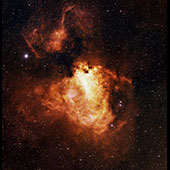M17 Swan Nebula
M17, also informally known as the 'omega nebula', the 'lobster nebula' and the 'swan nebula' (among other names), is one of the largest and brightest star-forming regions inside our galaxy. Its size and brightness make it one of the first nebulae to be discovered, which occurred in 1745. The hydrogen gas that gives it its distinctive red color is energized by hot, massive blue stars embedded in the nebula.
| Observatory: | WIYN Observatory Kitt Peak, Arizona |
|---|---|
| Telescope: | WIYN 0.9-Meter |
| Instrument: | Mosaic I |
| Astronomer: | T.A. Rector (University of Alaska Anchorage) |
| Date of Observation: | 06-25-1999 |
| Filters and Assigned Colors: | Hydrogen-alpha (orange), Oxygen [OIII] (green) and Sulfur [SII] (blue) |
| Exposure Times: | 6x5min in H-alpha, 5x5min in [OIII] and [SII] |
| Location of Image: | Sagittarius |
| Field of View: | 57.8 x 59.4 arcmin |
| Orientation: | North is left, East is down |
| Link to Larger Image | |
| Link to Full Resolution Image | |
| © Copyright Statement |
